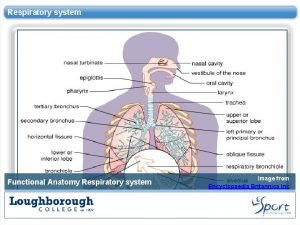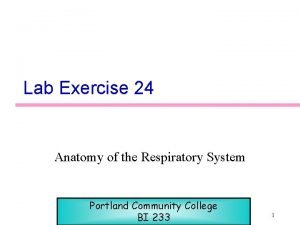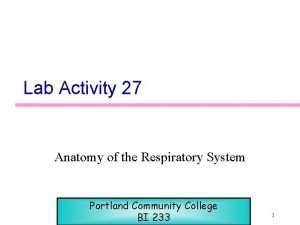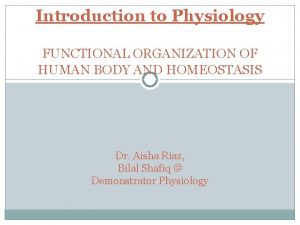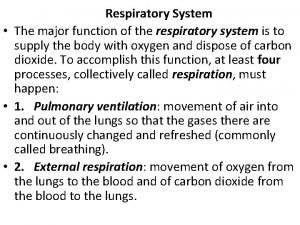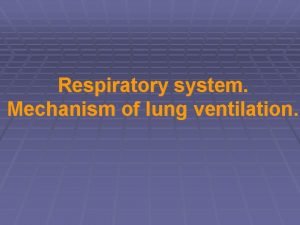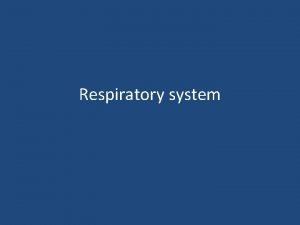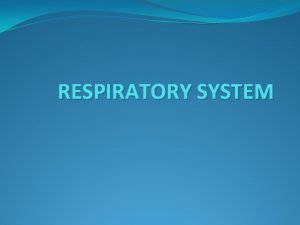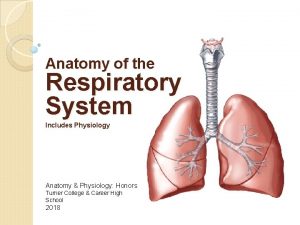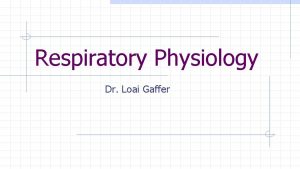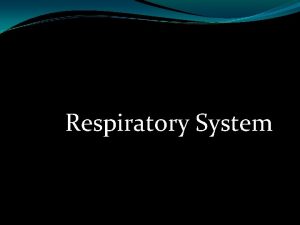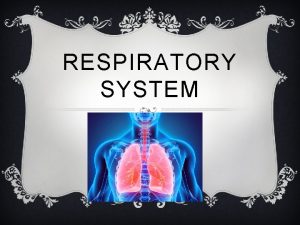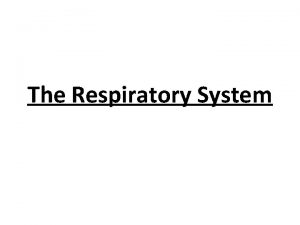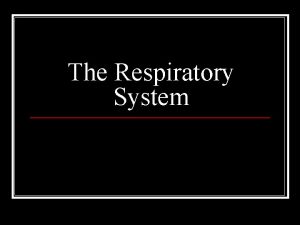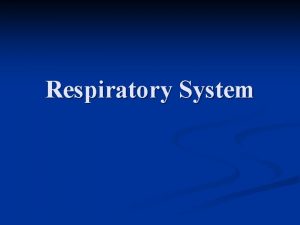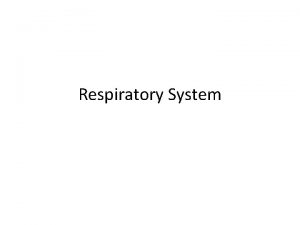Respiratory System Anatomy Physiology Function and Functional Anatomy










































- Slides: 42

Respiratory System Anatomy & Physiology

Function and Functional Anatomy n Function: to supply the body with oxygen (O) and dispose it of carbon dioxide(CO 2) n Functional Anatomy: there are 2 zones of the respiratory system I. Conducting Zone II. Respiratory Zone

Upper and Lower Respiratory Tracts

I. Conducting Zone Function: to warm, cleanse and humidify incoming air n Structures of the conducting zone n – – – Nose Pharynx Larynx Trachea Primary bronchii Lungs

I. Conducting Zone: Nose n A&P of the nose: – External nares: nostrils; where air enters – Nasal cavity: interior of the nose – Nasal septum: splits the n. cavity into 2; contains: • Mucosa: warms air and traps bacteria • Cilia: moves particles to throat to be digested • Olfactory receptors: nerve endings to detect smell

I. Conducting Zone: Nose n There are 3 main nasal structures: – Conchae: mucosa covered projections; increases surface area and creates air turbulence within nose – Palate: separates nasal and oral cavities • Hard palate: bony anterior section • Soft palate: non-bony posterior section – Paranasal sinuses: • Lightens the skull • Resonance chambers for speech • Produces mucus to drain into nasal cavity

Paranasal Sinuses

I. Conducting Zone: Pharynx n AKA the throat n Muscular passageway for both food and air n About 5 inches long n Houses the tonsils (clusters of lymphatic tissue)

I. Conducting Zone: Pharynx n 3 parts to the pharynx: – Nasopharynx: meets the auditory tube from ear; houses pharyngeal (adenoids) tonsils – Oropharynx: palantine tonsils @ end of soft palate – Laryngopharynx: lingual tonsils @ base of tongue

I. Conducting Zone: Larynx AKA voice box n Located inferior to pharynx n Function: routes air and food into proper tubes n Formed from 8 rigid hyaline cartilages and the epiglottis n – Epiglottis: a flap of elastic cartilage; closes larynx while swallowing; open during breathing

Larynx

I. Conducting Zone: Larynx – Thyroid Cartilage: AKA adam’s apple; the largest of the 8 cartilaginous rings – Larynx holds the vocal folds (cords) • Vibrate with expelled air producing sound • Vocal folds surround glottis • Glottis: slit-like passageway in the larynx

I. Conducting Zone: Trachea & Primary Bronchi n Trachea – AKA the windpipe – ~4 inches long – Lined with ciliated mucus – Cilia beats to propel dust and bacteria away from lungs n Primary Bronchi – There are 2; right and left – Runs from trachea to lungs – Air @ this point is warmed, humidified and cleansed

I. Conducting Zone: Lungs n Large paired organs n Apex: narrow, superior region, lying posterior to clavicles n Base: broad and inferior region; rests on diaphragm n Lungs divided into lobes and fissures

I. Conducting Zone: Lungs n Right Lung: – 3 lobes – 2 fissures • Horizontal • Oblique n Left Lung: – 2 lobes

Lungs

I. Conducting Zone: Lungs n Visceral Pleura: serous membrane surrounding each lung n Parietal Pleura: serous membrane lining the wall of the thoracic cavity – Both work to produce pleural fluid allowing for reduced friction b/n lung and wall; allows lungs to cling to wall

II. Respiratory Zone n Function: Where gas exchange takes place n Structures of the respiratory zone: – Respiratory bronchioles – Alveolar ducts – Alveolar sacs – Alveoli

II. Respiratory Zone: Bronchioles n Respiratory Tree – Primary bronchi branch off into right and left lungs – They then further divide into secondary and tertiary bronchi---ends at bronchioles – Bronchioles: the smallest of conducting zone passageways leading to the respiratory zone

Respiratory Tree

II. Respiratory Zone: Alveoli n Alveoli: small air sacs – Surrounded by alveolar sacs and connected by alveolar ducts—resembles grapes – Only site of gas exchange – Millions per lung – Walls made of squamos epithelial tissue

Respiratory Membrane n AKA Air-Blood Barrier – External surfaces of alveoli covered by pulmonary capillaries – Alveolar walls + capillary walls = respiratory membrane

Respiratory Membrane: Gas Exchange n Simple Diffusion: exchange of gasses across the vessel walls---DOWN the concentration gradient – Alveoli: holds air-CO 2, O 2 – Pulmonary Capillaries: holds blood CO 2 – Oxygen exchange occurs from alveoli to capillaries – Carbon dioxide exchange occurs from capillaries to alveoli

Respiration n Divided into 4 different events: 1. 2. 3. 4. Pulmonary Ventilation External Respiration Respiratory Gas Exchange Internal Respiration

Respiration: Pulmonary Ventilation There are 2 parts to pulmonary ventilation: A. Inspiration n – Inspiratory muscles: the diaphragm and intercostal muscles – Diaphragm contracts—moves inferiorly – Intercostals contract and lift rib cage; pushes sternum anteriorly

Inspiration

Respiration: Pulmonary Ventilation n Inspiration continued – Intrapulmonary volume increases – Intrapulmonary pressure decreases • Pressure less than atm. pressure – Air moves into lungs from outside of body until pressure inside cavity = atm. pressure

Respiration: Pulmonary Ventilation B. Expiration AKA exhalation – A passive process in healthy people – Inspiratory muscles relax, descending rib cage---lungs recoil – Thoracic and intrapulmonary volume decreases – Intrapulmonary pressure increases above atm. pressure—forcing air out of the body

Respiration: Pulmonary Ventilation n Forced Expiration – If respiratory passageways are impeded, expiration is an active process and muscles have to contract to decrease the volume of the cavity • Asthma • Bronchitis • Pneumonia

Expiration

Respiration: External Respiration n The actual exchange of gas between alveoli and capillaries in the lungs.

Respiration: Respiratory Gas Transport n The transport of respiratory gases throughout the body – Oxyhemoglobin Complex: oxygen attaches to hemoglobin on RBC’s; transports oxygen through body – Some oxygen carried in plasma – Carbon dioxide transported in plasma as a bicarbonate ion (HCO 3 -); some carried on hemoglobin

Respiration: Internal Respiration n The exchange of gases occurring between blood in capillaries and tissue cells----opposite of exchange in lungs.

Internal and External Respiration

Respiratory Volumes and Capacities n Tidal Volume (TV): normal quiet breathing – ~500 ml moves into and out of lungs with each breath n Inspiratory Reserve Volume (IRV): amount of air taken in forcibly over TV – ~2100 -3200 ml

Respiratory Volumes and Capacities n Expiratory Reserve n Residual Volume: Volume (ERV): after strenuous amount of air forcibly expiration exhaled over tidal – ~1200 ml air remains in lungs & cannot be expiration – ~ 1200 ml expelled voluntarily – Allows for continuous gas exchange between breaths

Respiratory Volumes and Capacities n Vital Capacity (VC): n Dead Space the total amount of Volume: air that exchangeable air enters the resp. tract & remains in the – ~4800 ml in healthy males conducting zone— – VC =TV+IRV+ERV never reaches alveoli – ~150 ml

Respiratory Control Centers n Located in medulla and pons of brain stem – Inspiratory and expiratory centers in medulla keep respiration rate ~ 12 -18 breaths per minute

Receptors Influencing Respiration n Chemoreceptors – Located in carotid and aorta arteries – Detect rising carbon dioxide levels and low oxygen levels in blood

Types of Breathing n Eupnea: normal respiratory rate n Dyspnea: labored/difficulty breathing n Orthopnea: dyspnea relieved by sitting upright n Apnea: momentary cessation of breathing

Types of Breathing

Types of Breathing n Hyperventilation: rapid and deep breathing (too much oxygen/too little carbon dioxide) n Hypoventilation: slow and shallow breathing (too little oxygen/too much carbon dioxide)
 Respiration
Respiration Functional anatomy of the respiratory system
Functional anatomy of the respiratory system Exercise 24 review sheet respiratory system physiology
Exercise 24 review sheet respiratory system physiology Respiratory zone
Respiratory zone Site:slidetodoc.com
Site:slidetodoc.com Anatomy and physiology unit 7 cardiovascular system
Anatomy and physiology unit 7 cardiovascular system Pectoral girdle acetabulum
Pectoral girdle acetabulum The upper respiratory tract
The upper respiratory tract Anatomy of the respiratory system
Anatomy of the respiratory system Functional organization of human body
Functional organization of human body What is the major function of the respiratory system
What is the major function of the respiratory system Spirogram diagram
Spirogram diagram Cuneiform cartilage
Cuneiform cartilage Circulatory system and respiratory system work together
Circulatory system and respiratory system work together Tattoo anatomy and physiology
Tattoo anatomy and physiology International anatomy olympiad
International anatomy olympiad Perfect vs imperfect flower
Perfect vs imperfect flower Anatomy and physiology bones
Anatomy and physiology bones Gastric ulcer differential diagnosis
Gastric ulcer differential diagnosis Liver anatomy
Liver anatomy Epigastric region
Epigastric region Epigastric vs hypogastric
Epigastric vs hypogastric Cytoplasmic granules
Cytoplasmic granules The central sulcus divides which two lobes? (figure 14-13)
The central sulcus divides which two lobes? (figure 14-13) 3 layers of muscle
3 layers of muscle Http://anatomy and physiology
Http://anatomy and physiology Chapter 1 introduction to human anatomy and physiology
Chapter 1 introduction to human anatomy and physiology Anatomy and physiology of appendix
Anatomy and physiology of appendix Aohs foundations of anatomy and physiology 1
Aohs foundations of anatomy and physiology 1 Aohs foundations of anatomy and physiology 2
Aohs foundations of anatomy and physiology 2 Anatomy and physiology of swine
Anatomy and physiology of swine Anatomy and physiology chapter 8 special senses
Anatomy and physiology chapter 8 special senses Chapter 13 anatomy and physiology of pregnancy
Chapter 13 anatomy and physiology of pregnancy Unit 26 self evaluation answers
Unit 26 self evaluation answers Science olympiad anatomy and physiology 2020 cheat sheet
Science olympiad anatomy and physiology 2020 cheat sheet Chapter 2 basic chemistry anatomy and physiology
Chapter 2 basic chemistry anatomy and physiology Degluttination
Degluttination Anatomy and physiology diabetes
Anatomy and physiology diabetes Anatomy and physiology chapter 7
Anatomy and physiology chapter 7 Anatomy and physiology coloring workbook chapter 14
Anatomy and physiology coloring workbook chapter 14 Chapter 10 blood anatomy and physiology
Chapter 10 blood anatomy and physiology Aohs foundations of anatomy and physiology 1
Aohs foundations of anatomy and physiology 1 Aohs foundations of anatomy and physiology 1
Aohs foundations of anatomy and physiology 1

